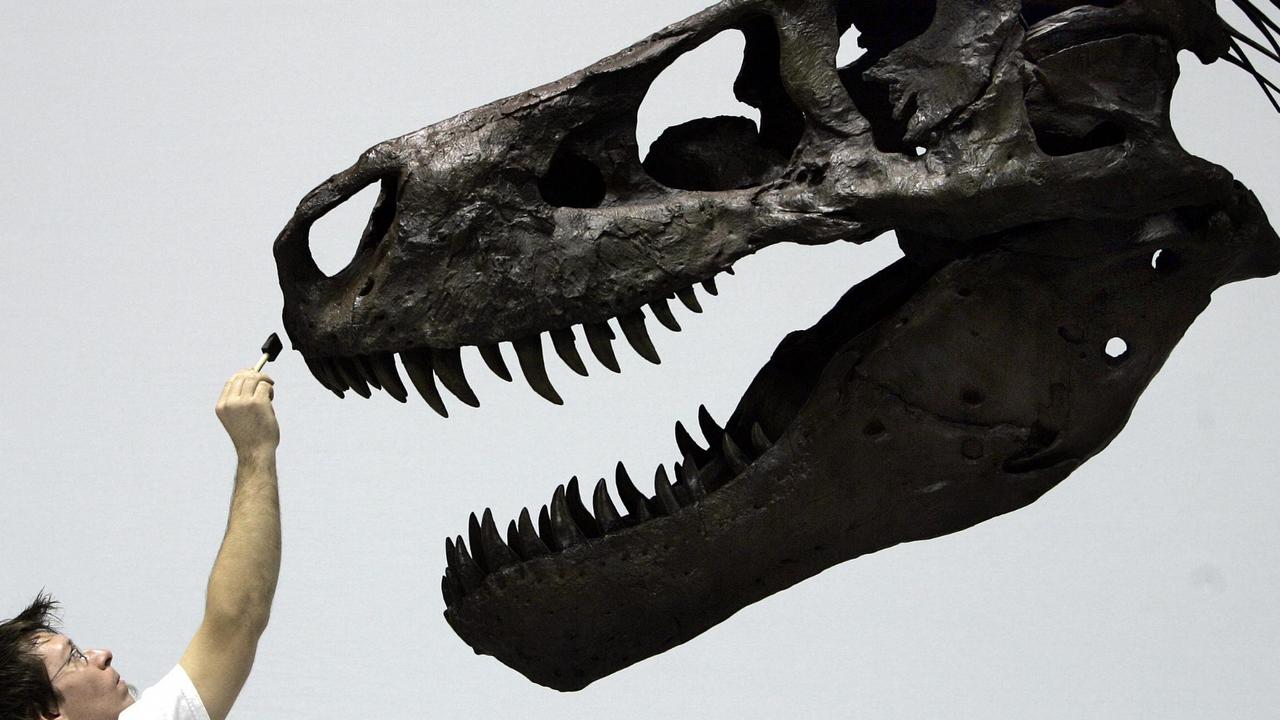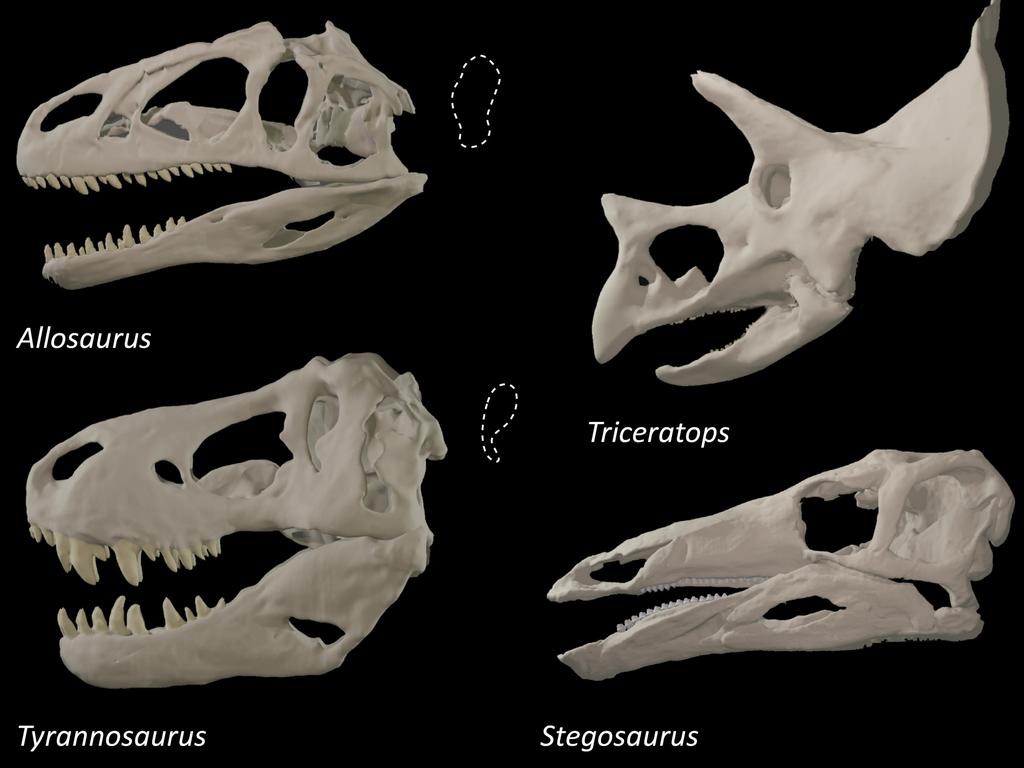Eye socket change built up bite force in Tyrannosaurus and friends
Impact from the ferocious bite of a T-rex was not restricted to its unlucky prey, as study finds the mighty lizard king evolved oval eye sockets to protect its skull from the force of its own attack

READING LEVEL: ORANGE
Tyrannosaurus rex had awe-inspiring bite force, with the huge meat-eating dinosaur’s bone-crunching chomp estimated to pack about 3630kg of power. That’s equal to the weight of three small cars ripping through each meal on its way down.
This bite strength was helped in T-rex and other large predatory* dinosaurs by a fascinating evolutionary* modification* in the skull, with the eye socket – called the orbital bone – becoming keyhole-shaped rather than circular, according to a study published on Thursday.
The study used computer simulations* to show that a skull with a circular eye socket was more vulnerable* to high stresses during biting, but the modified shapes seen in large meat-eating dinosaurs greatly reduced these stresses and enabled strong bite force without harming the skull.

“High bite forces and loads during feeding need to be accommodated by the skull and lower jaw,” said University of Birmingham palaeontologist Dr Stephan Lautenschlager, author of the research published in the journal Communications Biology.
“This can be achieved by having a stronger skull – more bone – or channelling the occurring stress and deformation* in such a way that the loads are reduced. This is achieved by the non-circular orbits.”
Dr Lautenschlager examined eye socket shape in 410 extinct* species, including 230 dinosaurs as well as some of their reptilian cousins such as the crocodile lineage* and the flying reptiles called pterosaurs. Of particular interest were theropods, bipedal* creatures that included all of the meat-eating dinosaurs.

The study found that once a theropod species acquired a skull length of about one metre or more, the shape of its eye sockets became keyhole-shaped.
This evolutionary change occurred independently in a variety of theropod groups globally over time, the study showed, including North American Tyrannosaurs, South America’s Giganotosaurus, Africa’s Spinosaurus, Europe’s Baryonyx and more.
Juveniles* of these big meat-eaters had circular eye sockets, with the change in shape occurring as the animal matured into adulthood.
The change was not present in smaller theropods or in the relatively few theropods that were herbivores. In fact, all plant-eating dinosaurs had circular eye sockets. However, the change was observed in some crocs that lived during the dinosaur age and exhibited* tremendous bite strength.

Dinosaurs first appeared roughly 230 million years ago during the Triassic Period, but the orbital modification took a long time to appear. An early example was North America’s Dilophosaurus, which lived roughly 190 million years ago during the Jurassic Period.
The orbital change meant narrower eye sockets. But while eyeball space may have been reduced, it made more space available for jaw muscles and added to skull robustness*. In these species, only the upper part of the eye socket was occupied by the eyeball, leading to smaller eye size relative to skull size, Dr Lautenschlager said, but the study did not examine whether the vision of T-rex and other large theropods was affected.
GLOSSARY
- predatory: animals that kill and eat other animals to survive
- evolutionary: gradual process of change and development in a species over time
- modification: alteration, adjustment, adaptation, change
- simulation: model, imitation or enactment of something, often in software for testing theories
- vulnerable: weakened, open to attack or damage
- deformation: distortion, change in the usual shape of something
- lineage: pedigree, family, ancestry
- extinct: species of animals and plants that no longer exist
- bipedal: walked on two legs
- juveniles: not fully grown or developed
- exhibited: showed, demonstrated, displayed
- robustness: being in strong, good condition
EXTRA READING
T-rex reigns as king of dinosaurs
‘Fierce’ dino fossil fetches fortune
Monstrous megaraptor unearthed in Argentina
QUICK QUIZ
- How much power in kilos of force was behind the T-rex’s crunch?
- The study used computer simulations to show what?
- The study examined the eye sockets of how many extinct species?
- All plant-eating dinosaurs have what shaped eye sockets?
- What happened when juvenile meat-eaters reached adulthood?
LISTEN TO THIS STORY
CLASSROOM ACTIVITIES
1. T-rex dinner menu
As you read in the Kids News article, a T-rex’s bite tore through its prey with the equivalent strength of about 3630kg of power behind it. T-rex must have needed that kind of bite strength because it had to tear through prey that was not easy to kill and consume. Now imagine that only the T-rex survived to roam Earth today and write a possible diet of what they might eat now (noting that T-rex was a big carnivore that mainly consumed other dinosaurs).
Menu of a T-rex:
Time: allow 25 minutes to complete this activity
Curriculum Links: English; Science; Critical and Creative Thinking
2. Extension
What pressure do humans put on their skulls by living in modern times?
Do you think different genders, races and cultures would have different bone structures dependent on their lifestyle and eating habits?
Time: allow 15 minutes to complete this activity
Curriculum Links: English; Health and Physical Education; Critical and Creative Thinking
VCOP ACTIVITY
Stretch your sentence
Find a “who” in the article – a person or an animal. Write it down.
Add three adjectives to describe them better.
Now add a verb to your list. What are they doing?
Add an adverb about how they are doing the action.
Using all the words listed, create one descriptive sentence.

